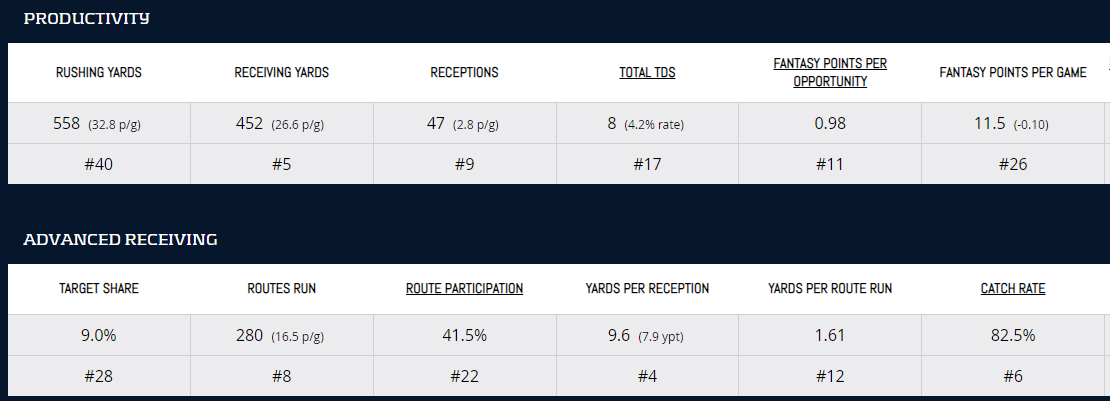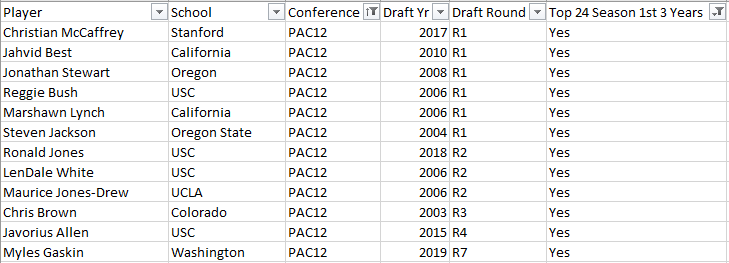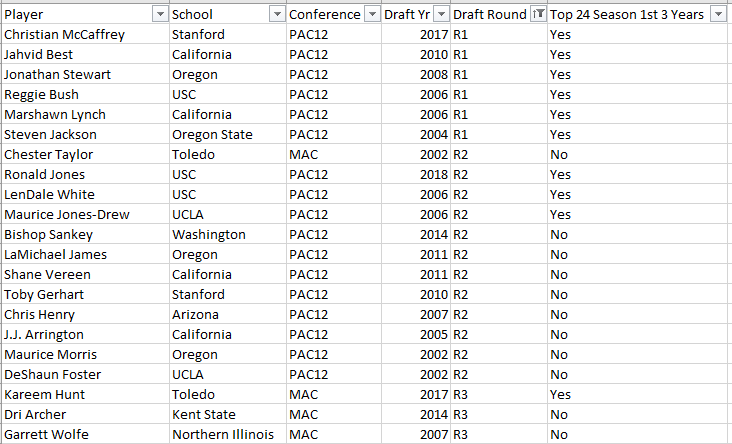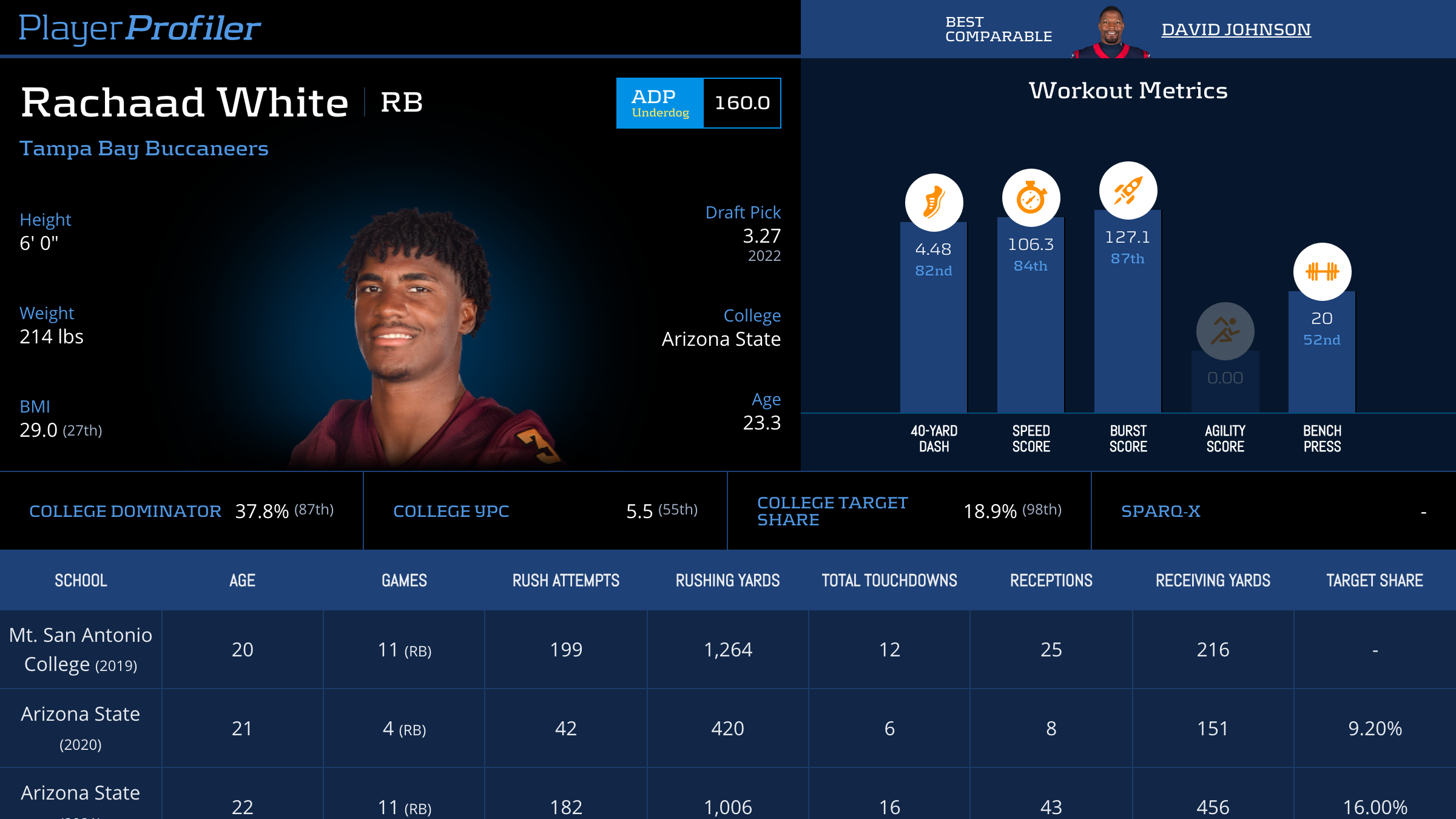When researching the success of MAC vs PAC-12 running backs drafted into the NFL, I looked at every RB drafted from these conferences since 2010. This narrowed my pool of running backs to 33. I decided to increase the sample size and looked back even further to 2001. This increased the sample size to 64 RBs. I defined success as a top-24 PPR season within a running back’s first three seasons. I eliminated running backs drafted in 2020-2022 as they have not played three NFL seasons. Which conference came out on top between the MAC vs PAC-12? The answer is as surprising as the Patriots making the playoffs.
The MAC
Of these 64 RBs drafted between 2001-2019, a mere eight came from the MAC, or 12.5-percent.
As you can see, only Kareem Hunt has delivered a top 24 season from the MAC running backs in this time.
PAC-12
For the PAC-12, 12 of the 58 players produced a top 24 RB season during their first three years in the NFL. That hit rate was 20.69-percent. This is higher than the MAC’s 12.5- percent hit rate by two-thirds.
After looking at the above PAC-12 RBs who “hit,” I realized the conference debate is pointless. The most important indicator always preached by fantasy analysts is DRAFT CAPITAL!!
Draft Capital
If we sort MAC vs PAC-12 running backs by the round they were drafted we find:
Yes, all Round 1 RBs from these two conferences hit. For Round 2, that rate drops 25-percent. It rebounds in Round 3 running backs with a hit rate of 33.3 percent. After that, the results are terrifying.
Of the remaining 39 RBs drafted in Round 4 through Round 7, only two “hit.” Round 4 Javorius Allen squeaked out a top 24 PPR season in his third year, and Round 7 Myles Gaskin proved productive as well.
How Can We Use These Results to Benefit Our Fantasy Teams?
The answer is simple: follow draft capital. If a running back is not drafted on Day 1 or Day 2, they are most likely not worth drafting.
We can also use apply these results to the RBs drafted from these divisions between 2020-2022 who have not played three seasons in the NFL. This list includes Zack Moss, Joshua Kelley, Eno Benjamin, Gary Brightwell, Jermar Jefferson, Rachaad White, Keaontay Ingram, and Brittain Brown.
At this point, we can give up on Moss, Kelley, Benjamin, Brightwell, and Jefferson. None have produced at a top 24 clip, and outside of Moss, whose team drafted James Cook in R2 from the SEC, none were drafted Day 1 or Day 2.
Bye Bye Ingram
We can also pour one out for Ingram who happens to be Benjamin’s teammate in Arizona. I wish I would have done this research before my rookie drafts because I liked Ingram coming out of USC. The Arizona landing spot looked perfect behind often injured James Conner. Coach or team centric drafting time and time again fails. Right CEH? Right Kelley? Kelley, like Ingram this year, walked into a great situation with the Chargers in 2020 and was given ample opportunity to seize a fantasy relevant role. However, he turned out to be “Just a Guy”.
With Benjamin a Round 7 running back who was not trusted in 2021, and Ingram being a Round 6 rookie from the same conference, the research results presented here scream at us to draft Darrel Williams as Conner’s handcuff and passing down reliever.

Darrel Williams Advanced Stats & Metrics Profile
Yes, Williams was undrafted, but he has already produced a top 24 PPR season where he was damn efficient.
The second takeaway I have is continue to draft Rachaad White in dynasty and redraft. The Round 3 RBs from these conference’s have a 33.3 percent hit rate. White is on a top-five offense, and White has a Christian McCaffrey-esque receiving profile along with better athleticism and size as seen below:
Draft him now, dynasty, redraft, and best-ball before a Leonard Fournette preseason injury causes his ADP to sky rocket!








